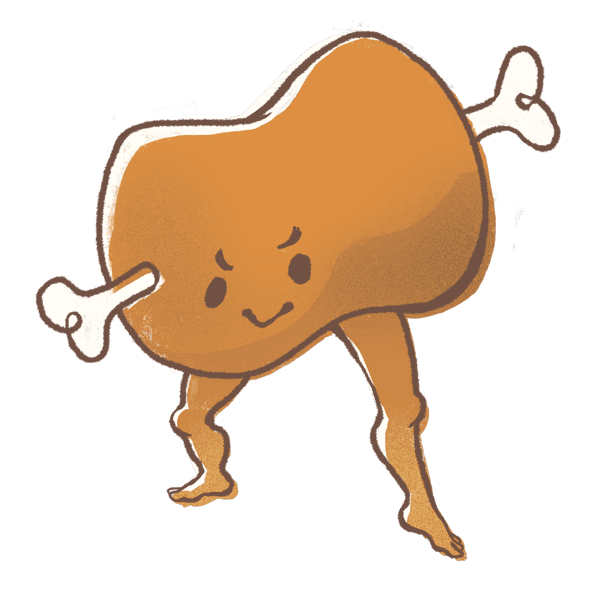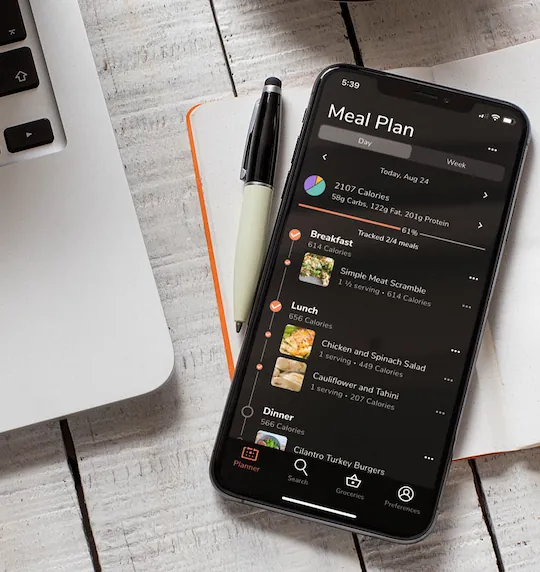Paleo Diet Plan

The paleo (short for paleolithic) diet plan is based on the idea that humans should eat food that closely resembles the diets of prehistoric humans. Early humans evolved as hunter-gatherers long before the invention of what we would recognize as modern-day agriculture. This diet plan attempts to recreate what humans ate from 2.5 million to 10,000 years ago, and eliminating foods that became popular after farming revolutionized what humans could eat.
Proponents of the paleo diet plan believe that it's healthier if humans ate more traditional staples of the human diet, such as meat, fruits and foraged vegetables, and less of the foods that only gained prominence after the emergence of agriculture about 10,000 years ago — so eating less grain, processed foods, legumes and the like. The appeal is that since the advent of agriculture there has been little time for core human metabolic processes to evolve — thus we should eat like cavemen.
As you can imagine, it's pretty difficult to know exactly what humans across the world ate on a daily basis in prehistoric times, before even the concept of a written language existed. However, based on what we know about technology levels and archeological records, we can make some educated guesses that it was probably a diet filled with a lot of natural, minimally processed foods.
Staple Foods and Snacks on a Paleo Diet Plan
So what are considered the core foods of a paleo diet plan? In a nutshell, simple but nutritious foods. Some basic categories include:
- Nuts and seeds
- Vegetables
- Fish such as tuna, mackerel and salmon
- Oils derived from fruits and nuts, such as olive oil or walnut oil
- Fruits
- Meat, especially from grass-fed animals or game animals
- Eggs
Some more specific examples of foods that are OK for the paleo diet include:
- Turkey, quail, goose, chicken, and duck
- Beef, lamb, pork, nitrate-free bacon, elk, bear, deer, moose, and rabbit
- Catfish, tuna, salmon, trout, bass, walleye, mackerel, cod, clams, lobster, crab, mussels, and shrimp
- Nuts and nut butters, including almonds, cashews, hazelnuts, walnuts, and brazil nuts
- Eggs, preferably from free-range birds
- Healthy fats from sources such as avocados, olive oil, coconut oil, and butter/ghee from grass-fed cows
- Cauliflower, broccoli, lettuces, carrots, peppers, cucumber, radishes, squashes, olives, and mushrooms
- Apples, peaches, bananas, berries, melons, tomatoes
- Acceptable sweeteners would be from sources such as dates, maple syrup and raw honey
Foods to Avoid on a Paleo Diet Plan
The ingredients to avoid on a paleo diet plan are all the foods that would only have been available in recent history to humans. These include:
- Grains, such as wheat, oats and barley (including whole grains and gluten-free), and their derivatives, like pasta and bread
- Dairy products
- Refined sugar, such as cane sugar, beet sugar and corn syrup
- Foods with lots of salt
- Potatoes, corn and rice
- Highly processed foods in general, such as soft drinks, vegetable oils, artificial sweeteners, margarine, trans fats, soybeans and soy-derived products
- Legumes, such as beans, peas and peanuts
- Beer, which is made from wheat, barley and hops (all on the paleo naughty list)
Benefits of the Paleo Diet Plan
Health experts like the paleo diet plan's reduction in highly processed foods and refined sugars, and like that it's high in fiber, potassium and antioxidants (such as found in vegetables, bananas, berries and fish).
The paleo diet plan has been found in some studies to be beneficial for those with or wanting to prevent Type 2 diabetes. One study found that a paleo diet planimproved blood-sugar levels and risk factors compared with a traditional diabetes diet plan. Another group of studies examined showed that a paleo diet plan compared similarly with other healthy, diabetic-friendly diet plans, such as the Mediterranean diet plan and a traditional diabetes diet plan. The paleo diet plan has also been found to be more satiating than other diet plans, meaning that people will consume fewer overall calories because they feel fuller and take longer to get hungry again.
One of the benefits of feeling satiated in a diet like the paleo diet plan is that it lessens the need for calorie counting and watching portion sizes. Some who follow the paleo diet plan also have a few "cheat" non-paleo meals each week.
Downsides of a Paleo Diet Plan
Some nutrition and health experts advise against eliminating entire categories of food from your diet, and say that the paleo diet plan's blanket exclusion of dairy could put someone at risk of calcium and vitamin D deficiency. They also point to the healthfulness of whole grains to fuel the body and brain.
It can be difficult to stay committed to diets that are too restrictive, and people with heart, kidney, liver or pancreatic disease have been recommended to follow a paleo diet plan under medical supervision. Despite a fair number of celebrity endorsements of the paleo diet plan (such as by Lebron James and the entire Miami Dolphins football team), researchers warn about blindly following the latest often commercialized fitness fads.
Nutrition on a Paleo Diet Plan
The first step in dieting to lose, maintain or gain weight is to calculate your TDEE (total daily energy expenditure) based on your current weight and exercise level. If your body burns 2,000 calories a day, then consistently eating fewer calories than that will help you lose weight, and eating more calories will cause you to gain weight.
Food is divided into three main macronutrients, all of which contain calories: Protein, carbohydrates and fat. Every diet plan needs to have a suitable amount of each of these three macronutrients. According to a Harvard study of the paleo diet plan, a standard macronutrient ratio is 30% protein, 30% carbohydrates and 40% fat.
A standard Paleo Diet Plan includes nutrient-dense fresh foods and steers participants away from highly processed foods with lots of sugar, salt and unhealthy fats, which is definitely good, but it's important to make sure certain vitamins and chemicals normally obtained from whole grains, dairy and legumes are still consumed.
Browse Diet Plans
 Keto Low-carb, high-fat diet focusing on ketosis for energy and weight management
Keto Low-carb, high-fat diet focusing on ketosis for energy and weight management  Vegan Excludes all animal products, emphasizing plant-based foods for health and ethics
Vegan Excludes all animal products, emphasizing plant-based foods for health and ethics  Vegetarian Plant-based diet including dairy and eggs, avoiding meat for health and ethics
Vegetarian Plant-based diet including dairy and eggs, avoiding meat for health and ethics  Paleo Emulates ancient diet with whole foods, free of processed items and grains
Paleo Emulates ancient diet with whole foods, free of processed items and grains  Mediterranean Rich in fruits, vegetables, fish, and olive oil for a balanced, heart-healthy diet
Mediterranean Rich in fruits, vegetables, fish, and olive oil for a balanced, heart-healthy diet  Low Carb Reduces carbohydrate intake, focusing on proteins and fats for energy
Low Carb Reduces carbohydrate intake, focusing on proteins and fats for energy  Low Fat Limits fat consumption, emphasizing lean proteins, grains, and vegetables
Low Fat Limits fat consumption, emphasizing lean proteins, grains, and vegetables  High Protein Prioritizes protein intake for muscle growth and repair, with balanced nutrients
High Protein Prioritizes protein intake for muscle growth and repair, with balanced nutrients  Gluten Free Avoids gluten, suitable for celiac or gluten sensitivity, focusing on alternative grains
Gluten Free Avoids gluten, suitable for celiac or gluten sensitivity, focusing on alternative grains  Other See how to follow other popular plans like Whole30, Low FODMAP, Pescetarian, and more
Other See how to follow other popular plans like Whole30, Low FODMAP, Pescetarian, and more
As Seen In
Available on Web, iOS, and Android
Eating smart has never been easier
Follow any eating style or create your own
You can customize popular eating styles like vegan and paleo to match your needs and preferences.
Reduce food waste
Planning ahead means less produce going bad in the fridge. Add what you already own to the virtual pantry and our algorithms will use it up with priority.
Take the anxiety out of picking what to eat
Make the important decisions ahead of time and on your own schedule. Then there's nothing to worry about when it's time to eat.
Automatic grocery lists
No more skipping meals because you're missing ingredients. Review your meals for the week and the grocery list automatically updates. Then get it delivered with our Instacart or AmazonFresh integration.
What Our Users Say

"Eat This Much not only helps me hit my macros, but also makes sure I'm not eating the same bland thing every day. I've lost 35 lbs over the past year, and with ETM, I'm eating and performing better than ever."
Sam Konowich @samkonthemankon

"I found out about Eat This Much and lost 32 lbs in 6 months! Now I'm a fit over 50 female in amazing condition, and this site is what I refer to several times a day to ensure I eat properly and manage my macros."
Meg M., awesome ETM user

"After being diagnosed with sleep apnea and high blood pressure, I picked up this app and followed the nutrition plan religiously. Since then I've lost over 40lbs. I still have 20lbs or so to go before I get to where I really want to be, but I'm thankful for the life this all has helped me achieve."
Sam A., awesome ETM user

"I started tracking my weight in April when I was 184lbs. In May I signed up for Eat This Much and immediately appreciated being able to just cook the menu and not worry about what to have for dinner. By November I was down to 155lbs and I still use Eat This Much today!"
Ben Kutil, Product designer
Disclaimer: These are real testimonials, but we're required to tell you that results aren't guaranteed. Eat This Much is a tool for planning your meals, and your success will depend on adhering to your planned meals and nutrition goals. Only you can make yourself improve your diet, but we'll be here to help.
Eat This Much is not a substitute for professional medical advice. You should consult with a medical professional before making significant changes to your diet.
For Health & Fitness Professionals
Powerful, fast meal planning to level up your business.



